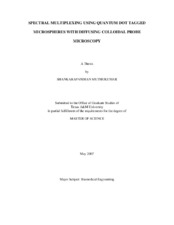| dc.contributor.advisor | Meissner, Kenith E. | |
| dc.creator | Muthukumar, Shankarapandian | |
| dc.date.accessioned | 2010-01-15T00:00:49Z | |
| dc.date.accessioned | 2010-01-16T01:32:06Z | |
| dc.date.available | 2010-01-15T00:00:49Z | |
| dc.date.available | 2010-01-16T01:32:06Z | |
| dc.date.created | 2007-05 | |
| dc.date.issued | 2009-05-15 | |
| dc.identifier.uri | https://hdl.handle.net/1969.1/ETD-TAMU-1245 | |
| dc.description.abstract | This work involves the development of a new technique that integrates Diffusing
Colloidal Probe Microscopy (DCPM) and luminescence to simultaneously measure
multiple particle-wall interactions. DCPM can be used to map potential energy profiles of
multiple particle-surface interactions simultaneously and accurately. Colloidal
semiconductor quantum dots were used for spectral multiplexing to enable monitoring of
multiple analytes at the same time.
DCPM combines Total Internal Reflection Microscopy (TIRM) and Video
Microscopy to simultaneously measure multiple particle-surface interactions with
nanometer resolution in particle-surface separation. By acquiring the scattered intensity
emitted by the particles, the separation distance can be calculated and subsequently the
forces of interactions between the particle and the surface.
This work demonstrates the use of luminescence instead of scattering as the mode
of detection in DCPM. The luminescence is provided by quantum dots which are
incorporated into polystyrene microspheres. The unique optical properties of quantum
dots enable the creation of an optically multiplexed system where microspheres are
tagged by quantum dots of different emission wavelengths. Scattering in DCPM may result in erroneous calculation of the potential energy
profiles because of particle polydispersity. Since scattering is dependent on particle size,
luminescence is introduced into the system and some interesting results are obtained.
These results illustrate that the effect of particle polydispersity is significantly reduced
when luminescence is used as the mode of detection. This combined with the DCPM
system’s sensitivity would enable the monitoring of multiple functionalized particlesurface
interactions simultaneously and accurately. | en |
| dc.format.medium | electronic | en |
| dc.format.mimetype | application/pdf | |
| dc.language.iso | en_US | |
| dc.subject | Quantum Dot | en |
| dc.subject | TIRM | en |
| dc.title | Spectral multiplexing using quantum dot tagged microspheres with diffusing colloidal probe microscopy | en |
| dc.type | Book | en |
| dc.type | Thesis | en |
| thesis.degree.department | Biomedical Engineering | en |
| thesis.degree.discipline | Biomedical Engineering | en |
| thesis.degree.grantor | Texas A&M University | en |
| thesis.degree.name | Master of Science | en |
| thesis.degree.level | Masters | en |
| dc.contributor.committeeMember | Bevan, Michael A. | |
| dc.contributor.committeeMember | Cote, Gerard L. | |
| dc.type.genre | Electronic Thesis | en |
| dc.type.material | text | en |
| dc.format.digitalOrigin | born digital | en |


